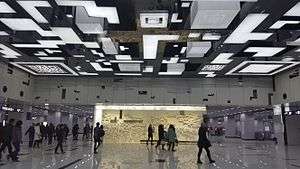Wangjiawan station (Wuhan Metro)
Wangjiawan Station (Chinese: 王家湾站) is a station on Line 4 of the Wuhan Metro. It entered revenue service on December 28, 2014. It is in Hanyang District.[1]
 | ||||||||||||||||
| Location | Hanyang District, Wuhan, Hubei China | |||||||||||||||
| Operated by | Wuhan Metro Co., Ltd | |||||||||||||||
| Line(s) |
| |||||||||||||||
| Platforms | 4 (1 island platform, 2 side platform) | |||||||||||||||
| Construction | ||||||||||||||||
| Structure type | Underground | |||||||||||||||
| History | ||||||||||||||||
| Opened | December 28, 2014 (Line 4) December 28, 2015 (Line 3) | |||||||||||||||
| Services | ||||||||||||||||
| ||||||||||||||||
Station Layout
| Ground | Exits | ||
| B1 | Station Hall | Station Hall, Ticket vending Machine, Service Center, Shops, Top-up for Wuhan Tong, Toilet | |
| B2 | Transfer floor | Transfer access | |
| Side platform, doors will open on the right | |||
| ← | Line 3 towards Zhuangyang Boulevard (Longyangcun) |
||
Line 3 towards Hongtu Boulevard (Zongguan) |
→ | ||
| Side platform, doors will open on the right | |||
| Transfer floor | Transfer access | ||
| B3 | ← | Line 4 towards Huangjinkou (Yulong Road) |
|
| Island platform, doors will open on the left | |||
Line 4 towards Wuhan Railway Station (Shilipu) |
→ | ||
Station
 Platform of Line 3
Platform of Line 3- Platform of Line 4
 Art Wall
Art Wall- Art Wall
Extrance
 Entrance B
Entrance B Entrance K
Entrance K Entrance L
Entrance L Elevator at Entrance M
Elevator at Entrance M
gollark: How is it more efficient, I mean.
gollark: How?
gollark: The clouds we use are much more efficient.
gollark: ??? Why?
gollark: They do some onboard computing too, which is more efficient since it's close to the clouds' storage.
References
- "四号线二期". Retrieved 2012-03-23.
| Wikimedia Commons has media related to Wangjiawan Station. |
This article is issued from Wikipedia. The text is licensed under Creative Commons - Attribution - Sharealike. Additional terms may apply for the media files.